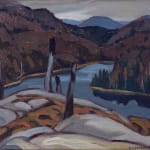Alfred Joseph Casson Canadian, 1898-1992
Port Coldwell, 1928
oil on board
9 x 11 in
22.9 x 27.9 cm
22.9 x 27.9 cm
signed "A. J. Casson" lower right; titled, signed and dated October 1928 on the reverse
Currency:
Plus d'images
We are excited to announce a rare and important A.J. Casson painting is now available for private sale. Painted in October 1928, the sketch depicts the remote settlement of Port...
We are excited to announce a rare and important A.J. Casson painting is now available for private sale. Painted in October 1928, the sketch depicts the remote settlement of Port Coldwell, where Casson joined Lawren Harris, A.Y. Jackson, and Franklin Carmichael during their sketching trip along the north shore of Lake Superior. At the time, Port Coldwell was little more than a small fishing village. To reach it, Harris famously arranged with railway workers to slow the train just enough for the artists to jump off with their gear in tow.
The 1928 trip was a formative moment in A.J. Casson’s career. Just two years earlier, he had been invited to join the Group of Seven by his friend and mentor Franklin Carmichael, whom he had apprenticed under at the commercial art firm Rous & Mann Ltd., replacing Frank Johnston. Though only 30 years old at the time and more than a decade younger than many of his peers, Casson produced what art historian Paul Duval described as “some of the best work he had yet achieved.” The conditions were harsh—snow fell nightly, and the cold, wet weather made watercolour impractical, resulting in all fieldwork being completed in oil on board. Despite the challenges, the trip proved highly productive and played a critical role in shaping Casson’s approach to composition and design in the Canadian landscape.
The 1928 trip was a formative moment in A.J. Casson’s career. Just two years earlier, he had been invited to join the Group of Seven by his friend and mentor Franklin Carmichael, whom he had apprenticed under at the commercial art firm Rous & Mann Ltd., replacing Frank Johnston. Though only 30 years old at the time and more than a decade younger than many of his peers, Casson produced what art historian Paul Duval described as “some of the best work he had yet achieved.” The conditions were harsh—snow fell nightly, and the cold, wet weather made watercolour impractical, resulting in all fieldwork being completed in oil on board. Despite the challenges, the trip proved highly productive and played a critical role in shaping Casson’s approach to composition and design in the Canadian landscape.
Provenance
Roberts Gallery, Toronto;Masters Gallery Ltd., Calgary;
Private collection, Toronto
2
sur
2









